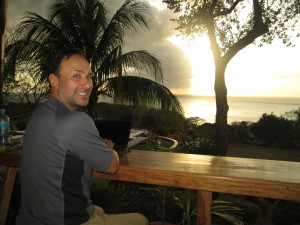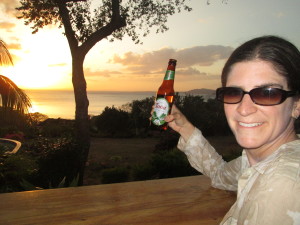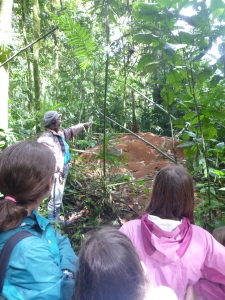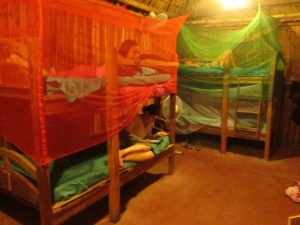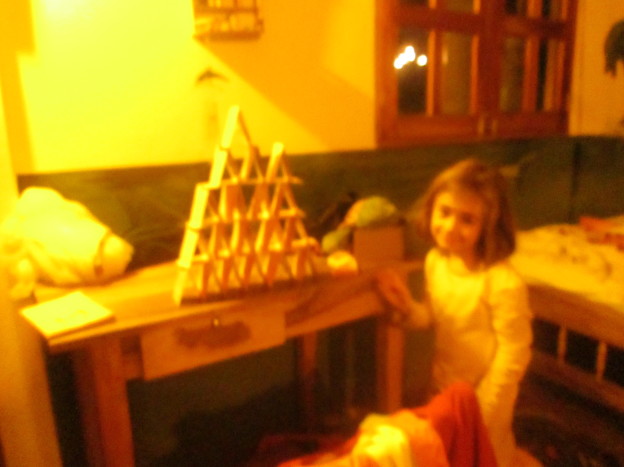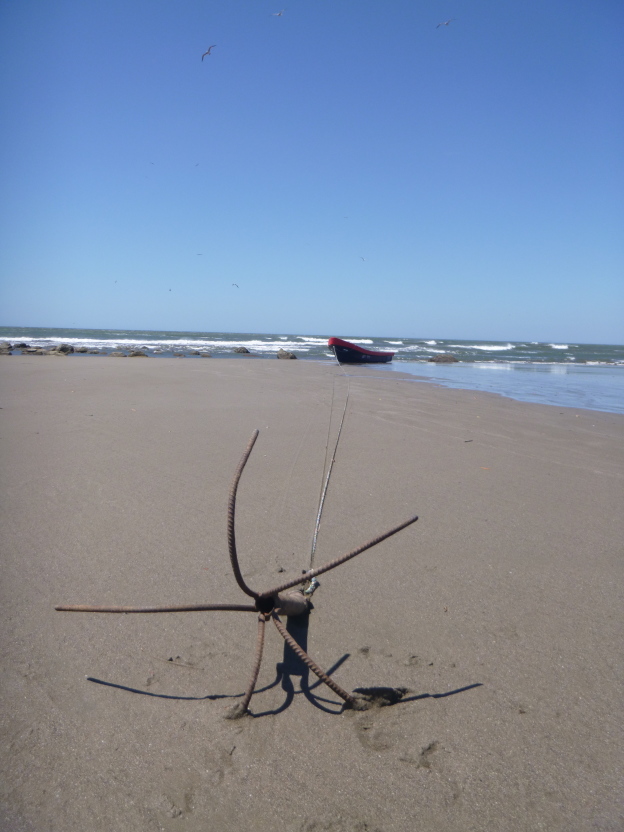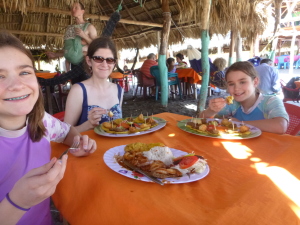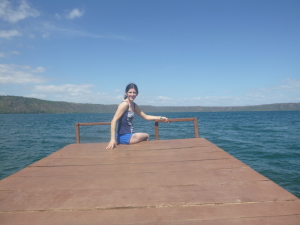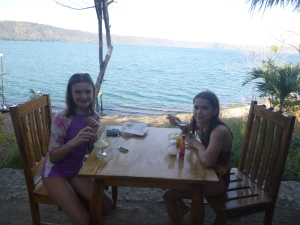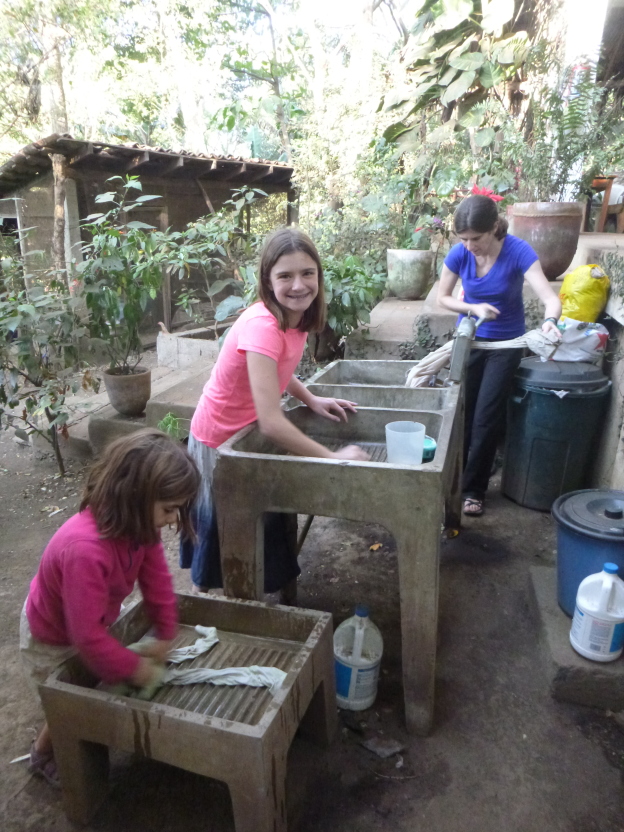To all of our friends at the Mariposa school who saw us off yesterday, particularly to Helen and Rodney, who walked us to the bus stop and helped us carry our things, and who witnessed the dramatic swooping u-turn executed by the microbus to UCA, the rapid loading of our family and posessions, and the hasty departure toward Managua, we’d like to say that we’ve made it to Leon. Thank you for your support.

Plenty of space on the Microbus
The travel was actually quite comfortable and efficient. The frist microbus didn’t stop often, but it did roll to an almost stop frequently while the man with the pot-leaf baseball cap whistled and yelled out the window to potential passengers. Even when people were getting on and off, the bus frequently kept its forward progress. We paid of an extra space for our backpacks — and luckIly there was space in this van for us and our stuff. We only had to wait at the bus stop five minutes!
The porter on the bus was effective at drumming up business — there was standing room only for much of the trip — and he was honest and efficient in giving us our change. (I was not entirely sure how this would work out because he waited until almost the end of the trip to collect from us and never actaully told us what the fare was. I noticed that almost everyone else paid with 20-cordova notes and got a pair of one-cordova coins back. We would need seis por diez y ocho. I gave him 150 cordobas and he took pretty great care, given he was half-way hanging out a van door, to get me correct change.
It is also probable that he gave me good directions to the terminal of the Leon bus. A few weeks of practice with our patient teachers La Mariposa did not really prepare me to understand this guy, though. To his great credit, he did give us a few sentences of direction before hoping back on the already-departing microbus. It turned out to be not too hard to get to the Leon bus. (Cost for traveling from San Juan de la Concepcion to Managua – UCA: 108 $C; time of travel, 12:30 pm – 1:25 pm.)*
The Leon bus was palatial in comparison. It was about half again as big as the first microbus, and it had room for luggage. As it happened, we still ended up with backpacks in the aisle because our big bags took up most of the storage space and there were a couple of seemingly European tourists on the bus who had all of their possessions with them as well. All the people on the bus got seats, though, only back packs were in the aisle.
As this bus was a little more comfortable — it had air conditioning! — and the trip was a little longer, the cost was a little higher — 51 $C per person. The best part was the we avoided waiting again. They squeezed our bags in, ushered us to seats, dealt with my ineptitude in with practicing Spanish and math simultaneously (for this bus, you pay before the bus leaves the terminal), and pulled out within 20 minutes of our exit from the Concepcion – Managua bus. We didn’t even have time to takea picture of the terminal, which was a chaotic sprawl of shed-like garages peppered with people trying to sell food to travelers. I don’t think we can hope for such timing for the rest of our bus journeys across Nicaragua. (Cost for travel from Managua to Leon: 51 cordovas times five people 255 $C, plus 20 $C tip; time of travel: 1:40 pm – 4:15 pm.)*
From there it was smooth sailing. Not a lot of stops. Good roads. We were met in the Leon parking lot/ bus depot by a swarm of bike taxis and allowed ourselves and our baggage to be swept up by two of them. It turned out to be a pleasant, if expensive, way to get to our hotel, passing a few open air markets and lot of Leonites. It’s hot here and our bike taxi operators were moving a lot of weight. They probably deserved the 100-cordova tip that they helped themselves to. (Cost of getting from the bus depot to our hotel: 300 $C, including tip; time: 4:20 – 4:30.)*
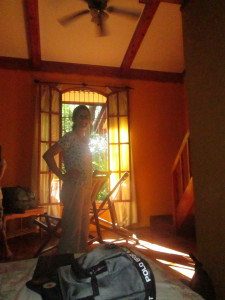
Our hotel room has a beautiful front window.
Then, there we were, having completed our own multi-stage trip on Nicaraguan public transportation. The hotel is beautiful; the city is vibrant, and almost pretty after dark. We have pounded the pavement in typical Pavlik vacation style (Jen’s fitbit buzzed in the early afternoon today and we still had plenty of walking to go). On advice from a fellow hotel guest who’s been to Leon a few times, we walked for an hour in search of “Pizzaria Lebano.” After much searching and a few inquiries we found “Hotel Lebano” and were told that they got out of the pizza business and into the hotel business about six years ago.

Looking for pizza on the streets of Leon
Jen had read that Leon is a good city for pizza and the kids were excited for the change from beans, rice and beets. Plan B was Hollywood Pizza, just around the corner from our hotel. It is about as American as it gets, with pictures of Elvis and Marilyn Monroe on the wall. But even with the pizza and pictures, it didn’t really feel like home until I visited the bathroom, which is shared by a neighboring cineplex. No matter where I am, the smell of popcorn and artificial butter substitute food product will always bring me back to the USA.

Its so white up there that I had to adjust the camera.
Today we roamed the town some more in the morning, sipping juice in a high-end hotel that used to be a convent and climbing to the top of the Basilica Catedral de la Asuncion. It’s the biggest cathedral in Central America and its roof is amazing to behold. Unlike other trips up bell towers, the view from this site is a secondary attraction. The roof itself is very elaborate, and the most striking feature is its utter whiteness.

Thats more like it.

Juices at the hotel/former convent, with thanks to Helen for the suggestion.
Of course, it must be white to reflect the sun and keep the cathedral manageably cool, but the effect is stunning. The paint is pristine and completely devoid of any pigment. To walk on it, you have to take off your shoes (and you really should wear sunglasses). The surface seems much better tended than any other part of the cathedral’s exterior — or any other part of Leon, for that matter. The whitewashing is completely flawless, unlike the nearby Mausoleum of Heroes and Martyrs, which is derelect in comparison to the cathedral roof. It has to be the coolest roof in Central America. Our feet didn’t even get hot when we walked on it. That roof is amazing.

The UV wand got a workout today.
Back on ground level we worked on some school stuff, explored the extensive courtyard encompassed by our hotel, and recreated the famous Roman Lunch from our Italy trip. It is very hot here, and we drank lots of water. Our life straw water bottle and magic want UV water purifier saw lots of action. Truthfully, we don’t know if we can drink the water, but we’re trying to be safe.

At the supermarket
We also visited a supermarket and survived an ATM scare that threatened to eat our afternoon with us desperately contacting our debit card company. It’s ok if only one bank in the country lets us use our ATM card, as long as that bank has plenty of branches. We need you, Bank of Nicaragua.

Historic reenactment of our Roman Lunch, this time in the courtyard
In the evening there was a trip to a museum of folklore that Jen can describe to you if she’d like. I’d much sooner not have to think about that place ever again. I wish I could expunge it completely from this blog and my mind, but this duty requires as many facts as I can muster. I am hoping there isn’t too much scaring among our younger charges. On the upside, Nadia found a nail clipper/bottle opener for 60 $C * that fits nicely in her collection.

Another one for the collection
Then, also on a lucky note, dinner was good enough to wipe out most of the evening’s earlier activities. Muchas gracias to the Nicaraguita Cafe. Eat here, everybody, when you’re in Leon. Our kids sure ate plenty.

We meet again, pasta and cheese.
Finally, I haven’t had the time to read Jen’s post about our trip to the volcano earlier this week, but I would like to say that I dedicate my accomplishments on that day to our Mariposa friends Melanie, Seker, and Bob from Wisconsin, who had the misfortune to leave the school before this particular outing took place, and whose self-organized expedition met with failure before the summit due to area wildfires. It was a beautiful trip, guys. Hope you have the chance to make it to the Masaya crater some time.
* Current exchange rate is around 27 cordovas to the dollar.


